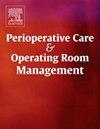提高手术效率:来自波多黎各三级护理中心周转时间分析的见解
IF 1
Q2 Nursing
Perioperative Care and Operating Room Management
Pub Date : 2025-05-13
DOI:10.1016/j.pcorm.2025.100499
引用次数: 0
摘要
手术室周转时间(TOT)对医院效率、患者护理和收入有显著影响。TOT的延迟与增加的运营成本、患者等待时间和工作人员负担有关。虽然现有文献大多侧重于高资源环境,但对低资源环境下手术室效率的研究有限。本研究旨在评估波多黎各一家三级护理医院的手术室周转时间,检查延误的原因及其对各手术室部门效率的影响。结果回顾性分析了我院4个外科共1036例择期手术。不同科室的平均周转时间(TOT)差异显著,心导管手术室的平均TOT最低,为26分钟,妇产科手术室的平均TOT最高,为56分钟。延迟率也各不相同,普通手术室的延迟病例比例最高,为17.7%,导尿管实验室的延迟病例比例最低,为6.6%。总体而言,延迟病例的TOT(平均1小时11分钟)明显长于非延迟病例(平均31分钟,p <;0.001)。延误的原因因部门而异,包括外科医生没空、人手不足、清理效率低下等等。我们的研究结果强调了导致TOT延迟的关键因素,这些因素在不同的外科部门有所不同。实施专门的周转小组、优化外科医生日程安排、改善与特定任务清单的沟通等策略可以减少延误,提高手术室效率。虽然这项研究的范围仅限于波多黎各的一家机构,但它为在类似的低资源环境中提高手术室效率提供了见解。本文章由计算机程序翻译,如有差异,请以英文原文为准。
Improving surgical efficiency: Insights from turnover time analysis in a tertiary care center in Puerto Rico
Introduction
Operating room (OR) turnover time (TOT) significantly impacts hospital efficiency, patient care, and revenue. Delays in TOT are associated with increased operational costs, patient waiting times, and staff burden. While much of the existing literature focuses on high-resource settings, there is limited research on OR efficiency in low-resource environments. This study aims to evaluate OR turnover times in a tertiary care hospital in Puerto Rico, examining the causes of delays and their impact on departmental efficiency across various operating rooms.
Results
A total of 1036 elective surgeries were reviewed across four surgical departments. Mean turnover time (TOT) varied significantly by department, with the cardiac catheterization OR having the lowest mean TOT of 26 min, and the ObGyn OR having the highest at 56 min. The rate of delays also varied, with the general OR having the highest percentage of delayed cases at 17.7 %, and the catheterization lab the lowest at 6.6 %. Overall, delayed cases had a significantly longer TOT (mean 1 h 11 min) compared to non-delayed cases (mean 31 min, p < 0.001). The causes of delays varied by department and included surgeon unavailability, inadequate staffing, cleanup inefficiencies, among others.
Discussion
Our findings highlight key factors contributing to TOT delays, which vary across different surgical departments. Strategies such as implementing dedicated turnover teams, optimizing surgeon scheduling, and improving communication with task-specific checklists could reduce delays and improve OR efficiency. While the study's scope is limited to a single institution in Puerto Rico, it provides insights for improving OR efficiency in similar low-resource settings.
求助全文
通过发布文献求助,成功后即可免费获取论文全文。
去求助
来源期刊

Perioperative Care and Operating Room Management
Nursing-Medical and Surgical Nursing
CiteScore
1.30
自引率
0.00%
发文量
52
审稿时长
56 days
期刊介绍:
The objective of this new online journal is to serve as a multidisciplinary, peer-reviewed source of information related to the administrative, economic, operational, safety, and quality aspects of the ambulatory and in-patient operating room and interventional procedural processes. The journal will provide high-quality information and research findings on operational and system-based approaches to ensure safe, coordinated, and high-value periprocedural care. With the current focus on value in health care it is essential that there is a venue for researchers to publish articles on quality improvement process initiatives, process flow modeling, information management, efficient design, cost improvement, use of novel technologies, and management.
 求助内容:
求助内容: 应助结果提醒方式:
应助结果提醒方式:


